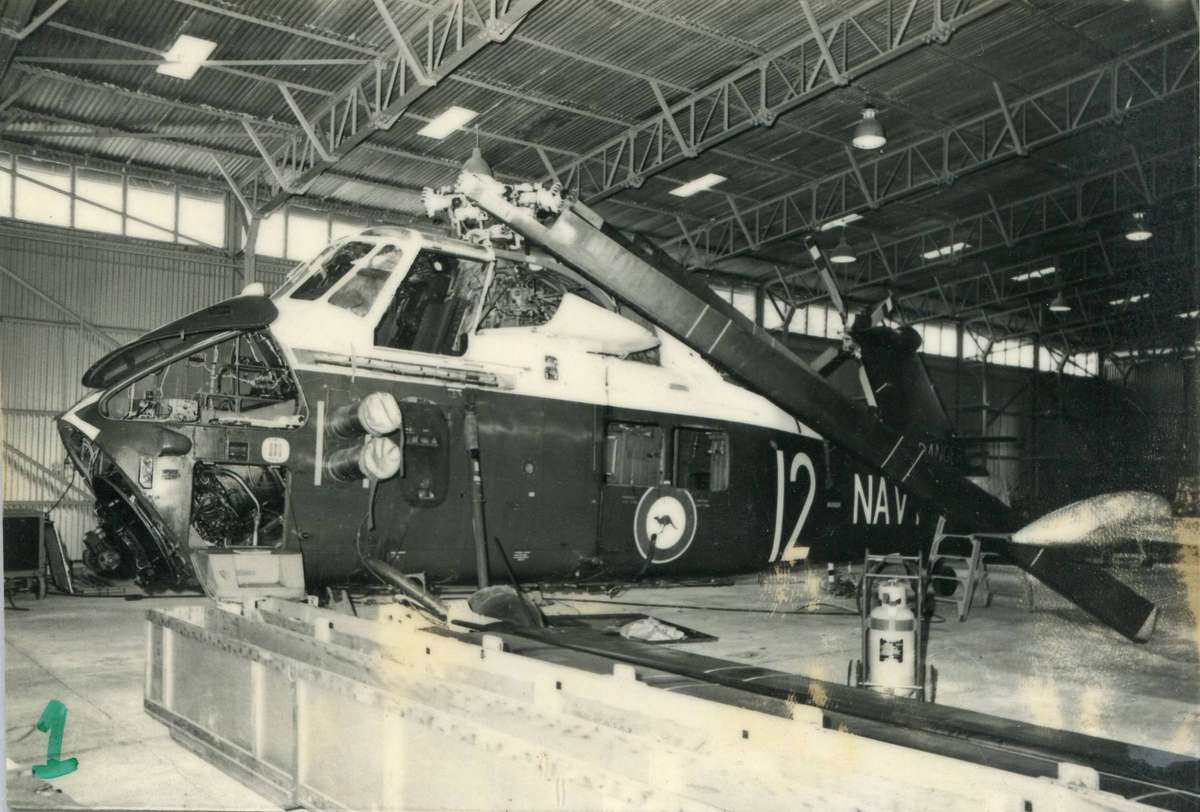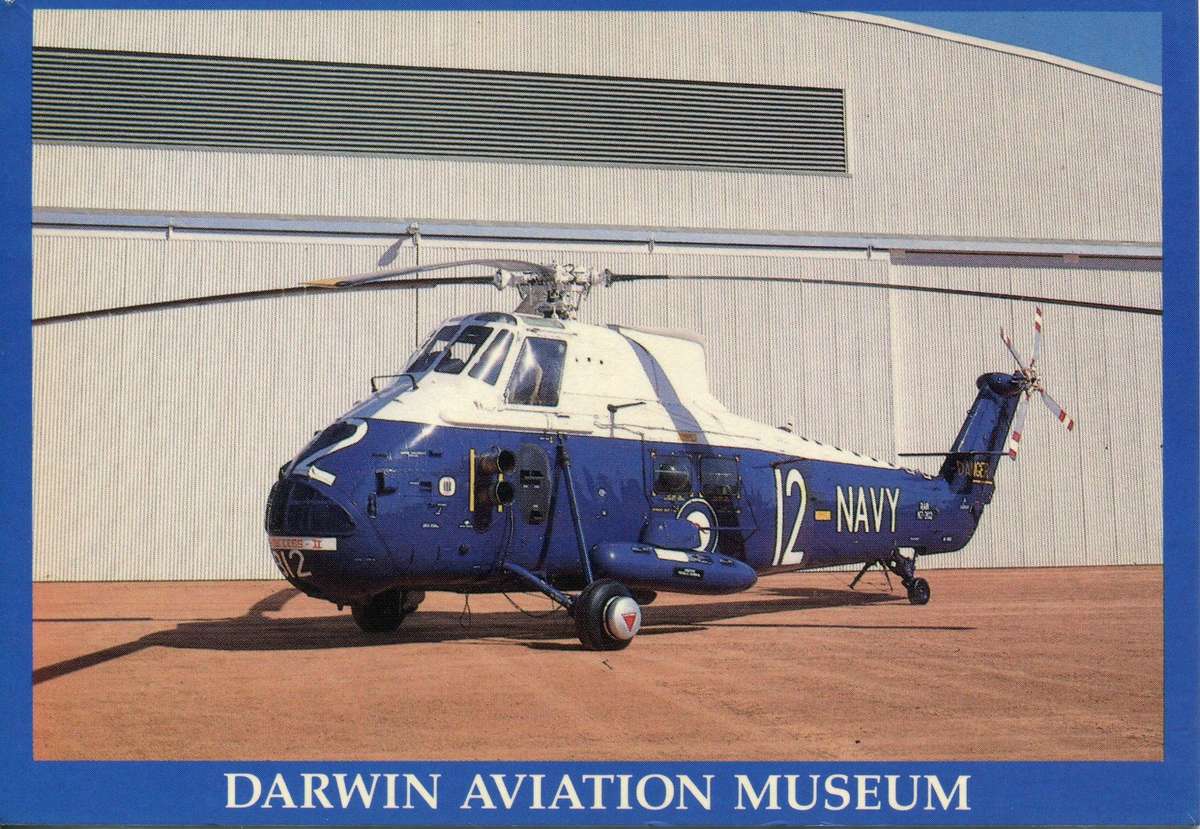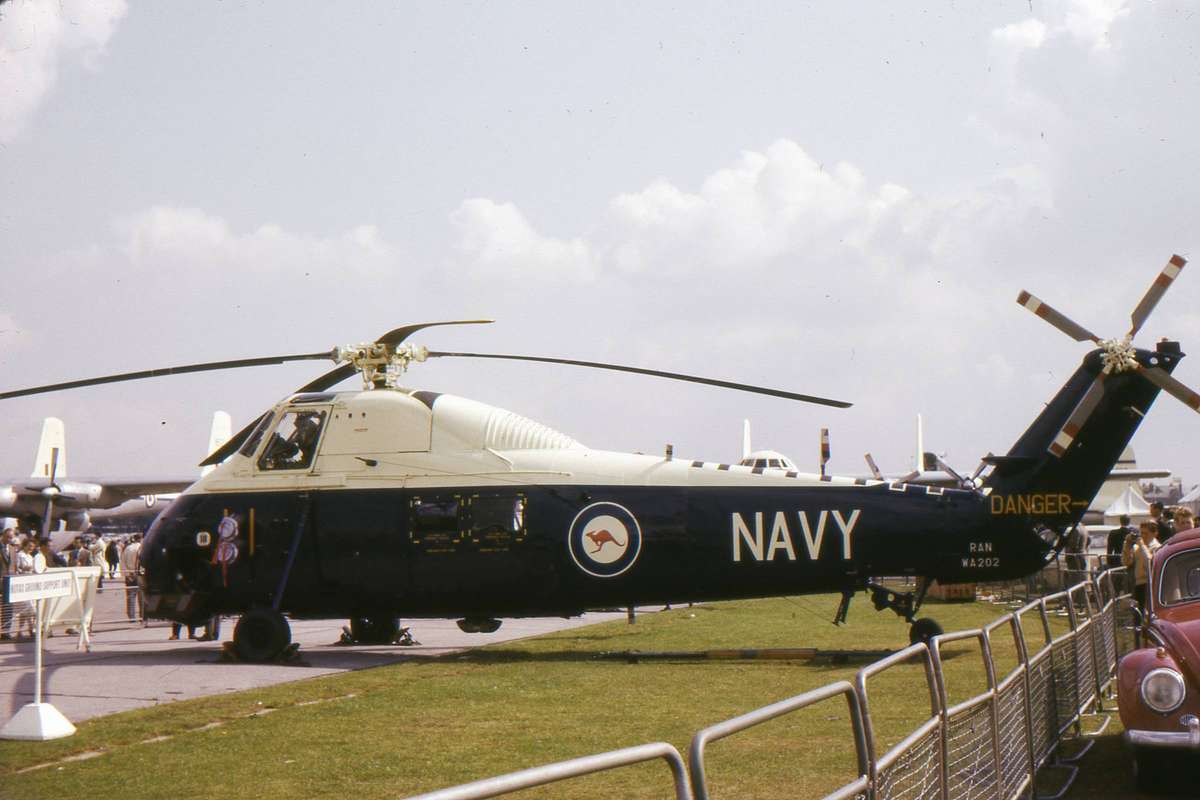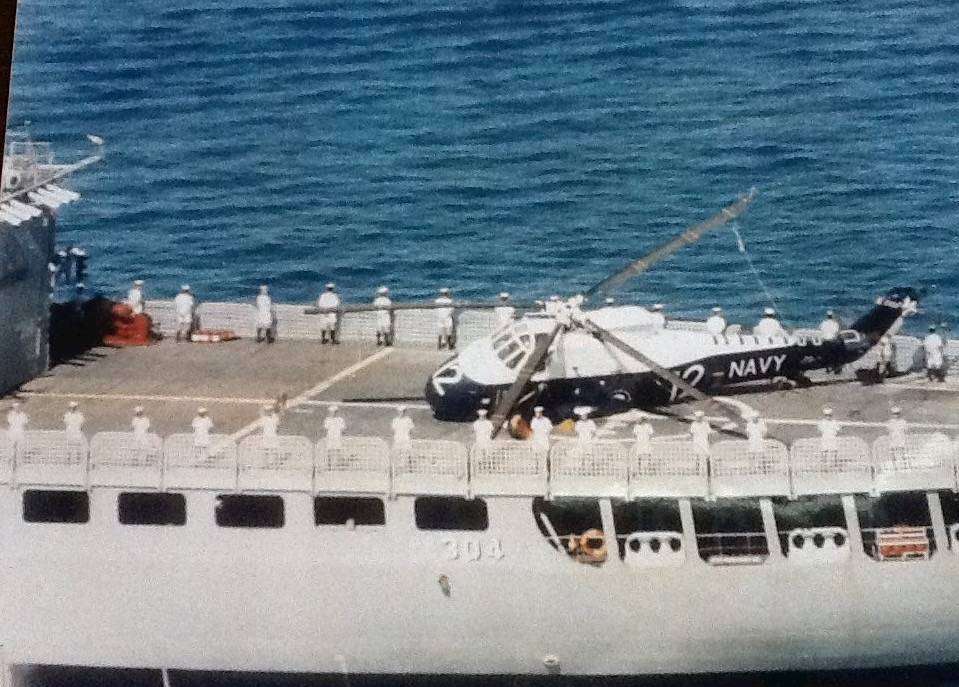Return to Wessex Heritage Page
This postcard issued by the Darwin Aviation Museum hints at the eventual fate of 812. Damaged beyond economical repair whilst off Darwin, the aircraft was patched up and donated to the museum.
History of the Aircraft
- First Flight 31/08/62.
- Substantial Damage 8/8/89 due to ground resonance aboard HMAS Success during Exercise Kangaroo 89. LEUT (P)White RAN, LEUT (P)Lister RAN, POA Cummings.
- To Darwin Aviation Museum 11/89.
- Currently on display.
Images of the Aircraft
Above: Wessex 812 pre 1968, still as a 31A model
History of the Accident:
Operating at sea approximately 140 nautical miles (nm) northeast of Darwin, HMAS Success Flight’s Wessex helicopter was running on deck during an intermediate stop while conducting an intra-Task Group logistic support mission.
The aircraft had completed the initial portion of the mission, the transfer of passengers to and from nearby HMAS Torrens to Success, and was preparing for departure with an underslung load for delivery to USS Oldendorf via Vertical Replenishment (VERTREP).
With the aircraft chocked and lashed on deck, the aircrewman had exited the aircraft to conduct cargo hook checks prior to commencing the underslung load portion of the mission.
As he re-embarked, the aircraft developed a violent padding side-to-side (rocking of the helicopter on its landing gear) that increased very rapidly to an uncontrollable degree. Recognising the onset of ground resonance, the pilot immediately attempted to shut down the engine by closing the high-pressure fuel cock.
One tie down lashing was seen to fall from the aircraft, allowing the aircraft to rapidly yaw to the right. The yaw collapsed the left-hand undercarriage radius arm, allowing all four rotor blades to strike the flight deck in turn. The aircraft came to rest approximately 30 degrees left wing down, and, once all violent motion had ceased, the three aircrew exited the aircraft unharmed.
The aircraft damage was initially assessed as Category 5, but later downgraded to Category 4. However, aircraft repairs were judged not economically justifiable due to the imminent Wessex life-of-type expiry.
Crew
Captain. 835 hours total with 509 hours Wessex
Co-pilot. 762 hours total with nil hours Wessex
Aircrewman. 2459 hours total and unknown hours on Wessex
Colour images from the Stephen Wood collection.
Accident summary
The aircraft had embarked on Success approximately six weeks earlier. Having completed visits to New Zealand and various South West Pacific islands, Success was in transit north for Exercise Kangaroo ’89.  During the transit, several aircrew from a Sea King squadron were transferred to Success to join their squadron detachment at RAAF Darwin. Two of those aircrew were involved in the Wessex incident. Success Flight’s aircrewman had been landed (put ashore) several days earlier for compassionate reasons, so an aircrewman from the Sea King squadron with extensive Wessex experience was operating as aircrewman for the incident sortie.
During the transit, several aircrew from a Sea King squadron were transferred to Success to join their squadron detachment at RAAF Darwin. Two of those aircrew were involved in the Wessex incident. Success Flight’s aircrewman had been landed (put ashore) several days earlier for compassionate reasons, so an aircrewman from the Sea King squadron with extensive Wessex experience was operating as aircrewman for the incident sortie.
The flight’s second pilot had kept a bridge watch overnight, and was stood down, so a Sea King pilot was carried for familiarisation purposes only. He had not flown in a Wessex before, and did not touch the flight controls at any time during the flight. While routinely operated by two pilots, the Wessex was approved for single-pilot operations.
The start-up had been completed without difficulty, with no significant padding or vibration during rotor engagement or prior to takeoff. The aircraft made the transit to Torrens and completed the transfer, winching one passenger to the deck and two into the aircraft. It then returned to Success and received a green deck; that is, clearance to land.
A normal landing was made, on centreline and within the landing circle. The approach and landing were smooth and without incident except that the captain and aircrewman suffered an intercom failure as the aircraft moved over the deck. On landing, the captain lowered the collective, switched off the Auxiliary Stabilisation Equipment (ASE), and waved in the flight deck team to apply chocks and lashings. He did not recall if he applied collective friction, but thought he had.
After the lashings had been applied and the passengers disembarked, the captain attempted to troubleshoot the intercom system. He was able to partially restore the intercom (he could hear, but could not be heard). He elected to continue the sortie, and wrote a brief kneeboard note to theco-pilot to the effect that he should assume control of the radios. In the meantime, the aircrewman disconnected his harness and exited the aircraft to check the Semi-automatic Cargo Release Unit (SACRU) and to fit the cargo strop.
As he re-embarked in the aircraft he noticed that it was padding from side to side, and remarked to the pilot that it “looked light on the wheels and he (the pilot) should beware of ground resonance”.The aircraft captain had become aware of the padding through the movement of the instrument console (loosely mounted to the airframe to allow vibration attenuation), which appeared to be moving more than normal. On hearing the aircrewman’s remark, he checked cockpit indications, and checked the collective lever to ensure it was fully lowered.
In the time taken for the aircrewman to step from the ship’s flight deck into the aircraft cabin the padding rapidly increased to an uncontrollable degree. The captain recognised ground resonance and immediately shut down the engine by closing the high-pressure fuel cock. He attempted to reach the rotor brake but was unable to do so due to the violence of the aircraft’s motion. The port aft tie down lashing was seen by a witness to fall from the aircraft tie down point. The aircraft tail yawed to starboard by approximately 45 degrees, and then lurched to port as the left hand undercarriage radius arm collapsed, allowing all four main rotor blades to strike the deck.
The aircraft came to rest approximately 30 degrees left wing down leaning on the external fuel tank. The captain applied the rotor brake before exiting normally. The aircrewman contemplated exiting the aircraft but heard the rotor blades striking the deck and saw shrapnel entering the sea. He elected to remain in the aircraft, and once all violent motion had ceased, jumped from the cabin door and moved forward down the port side of the ship. As he passed the nose of the aircraft. he saw the co-pilot exiting, quickly followed by the captain. The three aircrew mustered forward of the hangar on the port side unharmed.
Ground resonance
Ground resonance is a self-excited vibration that can be set up between the rotor system and the body of a helicopter on the ground. The onset of ground resonance can occur very quickly and has been known to destroy helicopters as the vibrations tear the aircraft apart. There are three conditions necessary to cause ground resonance:
- a self-excited vibration in the rotor system,
- a fuselage vibration, and
- contact with the ground.
Rotor system vibration. Ground resonance occurs primarily with fully articulated rotor heads. The drag dampers in an articulated head are designed to maintain the relative position of individual rotor blades with changing dynamic and drag forces as the blades rotate. If a damper is faulty, the blades will not be maintained in the correct relative positions, and the centre of gravity of the rotor system will be displaced from the axis of rotation, causing a divergent vibration. Rotor blades are tracked to ensure that the tip path planes of all blades match. This is done by making adjustments to pitch change links, trim tabs or balance weights. If wear or damage causes changes to these setting vibrations may result. Similarly, any imbalance caused by variations between individual rotor blade masses can set up sufficient vibration to cause ground resonance.
Fuselage vibration. Fuselage vibrations are not normally self-excited and therefore require an outside sustaining agent. This agent is the ground. Typical causes of fuselage vibration resulting from the helicopter being in contact with the ground include rough handling on landing which can cause the aircraft to rock from side-to side, or incorrect or varying tyre or oleo pressures.These can both generate a harmonic resonance between the oleos, the rotor system and ground leading to ground resonance. Helicopter undercarriage systems are designed such that they dampen out any fuselage vibration. This attenuation is most effective when the aircraft is firmly settled on its undercarriage.
Thus the aircraft is most susceptible to ground resonance when the undercarriage is only lightly in contact with the ground, for example when landing or taking off, or if the collective lever is raised for any other reason.
Recovery actions. Once initiated, ground resonance develops extremely rapidly and if no action is taken, the aircraft can shake itself to pieces within seconds. The actions to be taken will depend on the possibility of immediate take off. If possible, take off immediately. If take off is not possible, immediately shut down the engine and apply the rotor brake.
Investigation points of note
The investigation revealed a series of relevant issues recorded between 60-70 airframe hours prior to the incident.
These included padding on start, aircraft pads at minimum pitch on ground and disc tracking appears out, and padding apparent on ground. Recorded rectifications included charging tyres and oleos to correct pressures and extensions, the conduct of a low-power blade track, and a main rotor blade damper bleed. A review of maintenance requirements revealed that there was no recurring requirement that called for checking the fluid levels of either the main or tail oleos.
Witness statements indicated that the aircraft was padding virtually from the moment it arrived on deck, and that the padding gradually increased in severity until the aircrewman climbed into the cabin after completing external checks. Shortly after that point the aircraft entered fully developed ground resonance.
The reason for the initial padding could not be positively determined, but the Aircraft Accident Investigation Unit (AAIU) noted that numerous witnesses stated that the engine and/or rotor rpm appeared to be higher than normal. This is consistent with a collective lever position other than fully lowered. Trials conducted by the AAIU showed that the introduction of as little as 7-10 cm up collective caused engine rpm to noticeably increase. This created an impression to outside observers that the rotor rpm had increased as the noise generated by the blades (as a result of their increased pitch) changed significantly to create the illusion that they were travelling faster. The pilot stated that he could not recall if he had applied collective friction.
Examination of the friction device revealed that the friction collar clamping action was unsatisfactory. Even if applied, the friction clamp was unlikely to have provided effective restriction to collective movement. The AAIU considered the possibility that, as the pilot conducted troubleshooting of the intercom system, he may have allowed the collective to rise.
Aircraft Accident Investigation Unit findings
AAIU findings included the following:
- Wessex N7-202 suffered substantial damage as a result of entering ground resonance while secured on the flight deck of HMAS Success.
- The aircraft experienced padding from the moment it landed on the deck. No reason for this padding could be determined but was most likely due to main rotor system
- The initiator that coupled with the rotor excited vibration (padding) to produce ground resonance could not be accurately identified; however, in view of the strong witness evidence it was considered that the most likely explanation was that the collective lever was not fully down for some time prior to the onset of ground resonance.
- The pilot was distracted while he attempted to rectify the intercom problems, and this probably delayed his awareness of the onset of ground resonance.
- The pilot had decided to continue the sortie with a defective intercom.
Aircraft Accident Investigation Unit recommendations
AAIU recommendations included the following:
- Navy Air Logistics Office (NALO) review servicing requirements for the Wessex and other oleo fitted helicopters to ensure that fluid levels and pressures are checked at regular and appropriate intervals.
- NALO consider the introduction of collective locks on all RAN helicopters (such as those in the AS350 and B206) to allow the collective lever to be positively restrained.
Applicability to current operations
Ground resonance remains a hazard to helicopter operations. Aircraft designs incorporating either or both a fully articulated rotor head and a wheeled undercarriage are particularly susceptible.
The rotor systems of a stationery helicopter running on the ground are, effectively, still flying, thus necessitating the pilot’s full attention at all times. As can be seen, incipient ground resonance must be counteracted within seconds.
Current Location of this Aircraft:
N7-202 is located in the Darwin Aviation Museum just outside the city’s CBD. The exhibit notes that:
“…The helicopter…was one of six that assisted in the clean up of Darwin following Cyclone Tracy during “Operation Navy Help” January 1975 while based on HMAS Melbourne. It was damaged during “Kangaroo 89” a major defence exercise and then was repaired at HMAS Coonawarra (Darwin’s Naval Base) for display and subsequently presented to the museum in March 1990 as our first major exhibit. The Navy later returned to refurbish the cockpit and donate the Gazelle turbine engine now on display beside the aircraft. The Navy have replaced all of these helicopters with Sea King helicopters. Society members completed a major rebuild of the Wessex in 2006 to replace the severely corroded external magnesium skin.”
A photograph of the aircraft at a recent open day (Image courtesy Mark Pourzenic):









